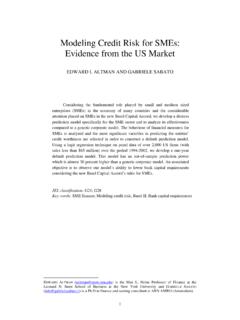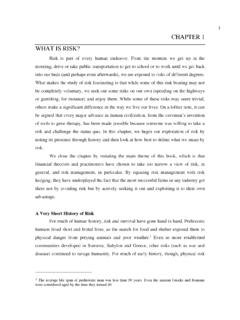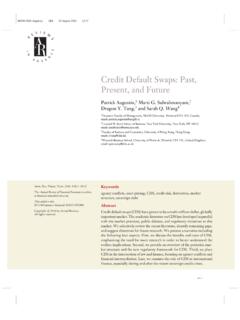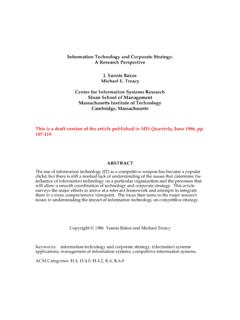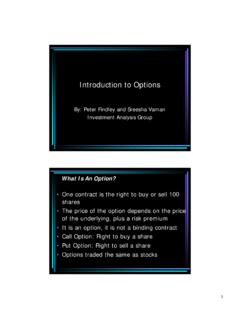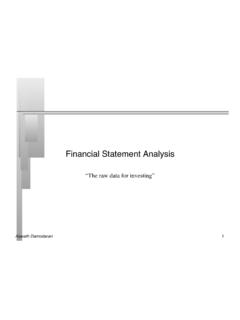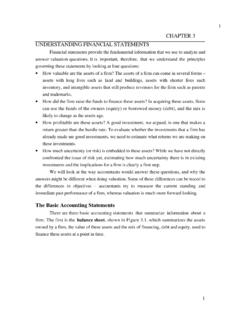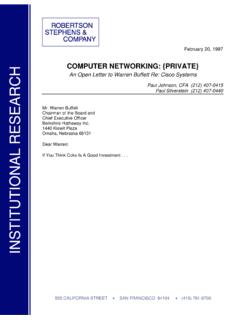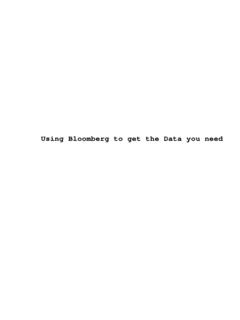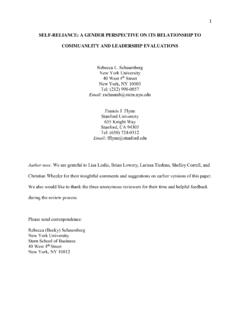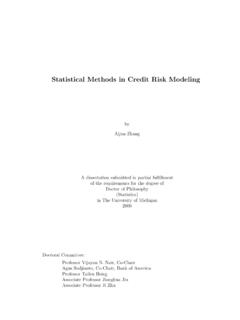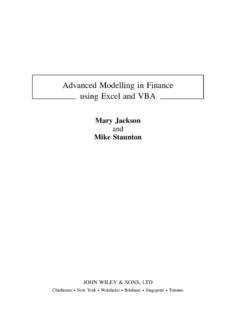Transcription of Default Recovery Rates and LGD in Credit Risk …
1 Default Recovery Rates and LGD in Credit Risk modeling and Practice Edward I. Altman** Abstract Evidence from many countries in recent years suggests that collateral values and Recovery Rates on corporate defaults can be volatile and, moreover, that they tend to go down just when the number of defaults goes up in economic downturns. This link between Recovery Rates and Default Rates has traditionally been neglected by Credit risk models, as most of them focused on Default risk and adopted static loss assumptions, treating the Recovery rate either as a constant parameter or as a stochastic variable independent from the probability of Default .
2 This traditional focus on Default analysis has been partly reversed by the recent significant increase in the number of studies dedicated to the subject of Recovery rate estimation and the relationship between Default and Recovery Rates . This paper presents a detailed review of the way Credit risk models, developed during the last thirty years, treat the Recovery rate and, more specifically, its relationship with the probability of Default of an obligor. We also review the efforts by rating agencies to formally incorporate Recovery ratings into their assessment of corporate loan and bond Credit risk and the recent efforts by the Basel Committee on Banking Supervision to consider downturn LGD in their suggested requirements under Basel II.
3 Recent empirical evidence concerning these issues and the latest data on high-yield bond and leverage loan defaults is also presented and discussed. Keywords: Credit rating, Credit risk, Recovery rate, Default rate JEL Classification Numbers: G15, G21, G28 *This is an updated and expanded review of the original article by Altman, Resti and Sironi (2006). **Max L. Heine Professor of Finance and Director of the Credit and Debt Markets Research Program, NYU Salomon Center, Stern School of Business, New York, 11. Introduction Three main variables affect the Credit risk of a financial asset: (i) the probability of Default (PD), (ii) the loss given Default (LGD), which is equal to one minus the Recovery rate in the event of Default (RR), and (iii) the exposure at Default (EAD).
4 While significant attention has been devoted by the Credit risk literature on the estimation of the first component (PD), much less attention has been dedicated to the estimation of RR and to the relationship between PD and RR. This is mainly the consequence of two related factors. First, Credit pricing models and risk management applications tend to focus on the systematic risk components of Credit risk, as these are the only ones that attract risk-premia. Second, Credit risk models traditionally assumed RR to be dependent on individual features ( collateral or seniority) that do not respond to systematic factors, and therefore to be independent of PD.
5 This traditional focus only on Default analysis has been reversed by the recent increase in the number of studies dedicated to the subject of RR estimation and the relationship between the PD and RR (Fridson, Garman and Okashima [2000], Gupton, Gates and Carty [2000], Altman, Resti and Sironi [2001], Altman, Brady, Resti and Sironi [2003 and 2005], Frye [2000a, 2000b and 2000c], Hu and Perraudin (2002), Hamilton, Gupton and Berthault [2001]), Jarrow [2001]), Jokivuolle and Peura [2003] and Acharya, Bharath and Srinivasan (2007). This is partly the consequence of the parallel increase in Default Rates and decrease of Recovery Rates registered during a substantial part of the 1999-2009 period.
6 More generally, evidence from many countries in recent years suggests that collateral values and Recovery Rates can be volatile and, moreover, they tend to go down just when the number of defaults goes up in economic downturns. Indeed, first half results in 2009 ( year-to-date) indicate that the Default rate on high-yield bonds will reach a record high level in 2009 and Recovery Rates will fall to perhaps the lowest level in history, at least in the modern high yield bond era ( year-to-date, Altman and Karlin (2009) and Keisman and Marshella (2009). This chapter presents a detailed review of the way Credit risk models, developed during the last thirty years, have treated the Recovery rate and, more specifically, its 2relationship with the probability of Default of an obligor.)
7 These models can be divided into two main categories: (a) Credit pricing models, and (b) portfolio Credit value-at-risk (VaR) models. Credit pricing models can in turn be divided into three main approaches: (i) first generation structural-form models, (ii) second generation structural-form models, and (iii) reduced-form models. These three different approaches together with their basic assumptions, advantages, drawbacks and empirical performance are reviewed in sections 2, 3 and 4. Credit VaR models are then examined in section 5. The more recent studies explicitly modeling and empirically investigating the relationship between PD and RR are reviewed in section 6.
8 In Section 7, we discuss BIS efforts to motivate banks to consider downturn LGD in the specification of capital requirements under Basel II. Section 8 reviews the very recent efforts by the major rating agencies to provide explicit estimates of Recovery given Default . Section 9 revisits the issue of procyclicality and Section 10 presents some recent empirical evidence on Recovery Rates on both defaulted bonds and loans and also on the relationship between Default and Recovery Rates . Section 11 concludes. 2. First generation structural-form models: the Merton approach The first category of Credit risk models are the ones based on the original framework developed by Merton (1974) using the principles of option pricing (Black and Scholes, 1973).
9 In such a framework, the Default process of a company is driven by the value of the company s assets and the risk of a firm s Default is therefore explicitly linked to the variability of the firm s asset value. The basic intuition behind the Merton model is relatively simple: Default occurs when the value of a firm s assets (the market value of the firm) is lower than that of its liabilities. The payment to the debtholders at the maturity of the debt is therefore the smaller of two quantities: the face value of the debt or the market value of the firm s assets. Assuming that the company s debt is entirely represented by a zero-coupon bond, if the value of the firm at maturity is greater than the face value of the bond, then the bondholder gets back the face value of the bond.
10 However, if the value of the firm is less than the face value of the bond, the shareholders get nothing and the bondholder gets back the market value of the firm. The payoff at maturity to the bondholder is therefore equivalent to the face value of the bond minus a put option on the value of the firm, with a 3strike price equal to the face value of the bond and a maturity equal to the maturity of the bond. Following this basic intuition, Merton derived an explicit formula for risky bonds which can be used both to estimate the PD of a firm and to estimate the yield differential between a risky bond and a Default -free bond. In addition to Merton (1974), first generation structural-form models include Black and Cox (1976), Geske (1977), and Vasicek (1984).
